Introduction
Before we moved to Portugal, we were conscientious recyclers. We had a whole corner of our pantry outfitted with big plastic bins to collect bottles and cans, paper, and cardboard.
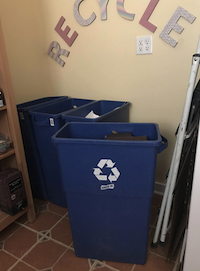
We also had a large compost pile behind the barn.
Out in the county where we lived, we didn’t have garbage pickup, so about once a month I would load my truck with garbage cans and recycling bins and drive 3 miles to the landfill. Lots of people separated out their recyclable items and put them in the containers there.
But not everyone did it. I’d often see cardboard, aluminum cans, and glass bottles in the trash containers – all of it headed for the landfill area.
Folks in town had better options. They could request a big plastic toter for their recyclables that would be emptied by the city crews once a week.
To be honest, I never really knew where all that stuff went. I recall reading once that the cans and bottles were hauled about 75 miles to be processed and resold by a company in Kentucky. The economics of the process weren’t clear, either. I think the county basically gave the stuff away in order to have it picked up.
That whole process was organized and managed in our little community. In the next county over, it could be done very differently, if it was done at all. To my knowledge, there were no statewide rules that mandated how recycling was performed. There were certainly no nationwide regulations for common household recycling.
Even before we moved to Portugal, I learned that recycling was done differently over here. We first learned about it from our friend Nancy Whiteman who wrote about it on her blog, Expat in Portugal. (You should read it for more than just recycling!) Nancy introduced us to the ecopontos, the large containers that sit on almost every block.
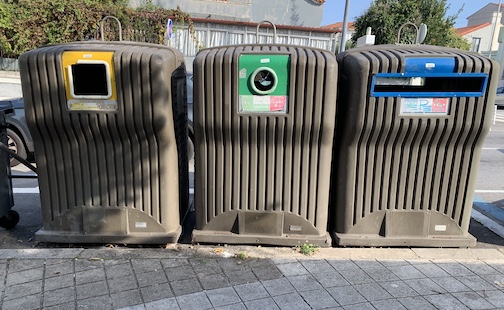
It appeared that Portugal had a well-organized program for recycling.
In the time we’ve been here in Porto, I’ve become accustomed to making the short walk from our apartment building to the nearest ecoponto, about a half block away. There are two other installations within 100 meters either way.
I’m not quite used to the pre-dawn banging and clanging and glass breaking that happens a few times each week when the city crews come to empty one of the bins, but with time I’ll probably learn to sleep through that, too.
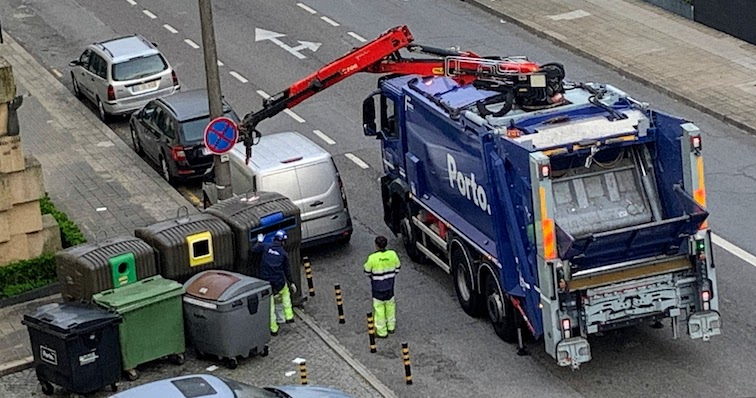
I’ve also become increasingly curious about how it all came about and what happens behind the scenes. So I did some Googling and reading to learn more about it. Here’s a summation of what I’ve learned so far.
How did all this start?
It’s probably incorrect to call what’s happening here “recycling”, because that is only one aspect of a broader program of waste management that originates from directives issued by the European Commission. These are what we would call “top down” mandates – instructions that every member country in the EU is obligated to follow.
Some policies and directives date back to the 1970’s and 1980’s, but the current approach is published as the “Waste Framework Directive”, originally adopted by the European Parliament in 2008.
The Waste Framework Directive is a comprehensive document that does several things:
- It defines important terms to create a common language for talking about the topic. Two that are relevant for today’s discussion are:
- Waste: any substance or object which the holder discards or intends or is required to discard. (In layperson’s terms, it’s the stuff we throw away.)
- Municipal Waste: mixed waste and separately collected waste from households, including paper and cardboard, glass, metals, plastics, bio-waste, wood, textiles, packaging, waste electrical and electronic equipment, waste batteries and accumulators, and bulky waste, including mattresses and furniture. (Like household waste, only from a whole town.)
(The Directive defines other kinds of waste, like toxic waste and hazardous waste, but for today we’ll focus on the kinds of things that we’re likely to acquire and later throw away.)
- Waste: any substance or object which the holder discards or intends or is required to discard. (In layperson’s terms, it’s the stuff we throw away.)
- It emphasizes the need to protect the environment and human health.
- It sets aggressive targets for the reduction of waste materials that EU member countries must attempt to meet and spells out how progress is to be reported. An example is the target for increasing the percentage of municipal waste that is prepared for re-use or recycling:
- By 2020, the percentage should be 50% by weight
- By 2025, 55%
- By 2030, 60%
- By 2035, 65%
- It positions the waste management program as one component in ensuring the long-term competitiveness of the European Union.
- It puts all of this activity in the context of a transition to a “circular economy” – a different economic model where products and materials are extensively recycled and reused, minimizing demand for new resources and minimizing waste.
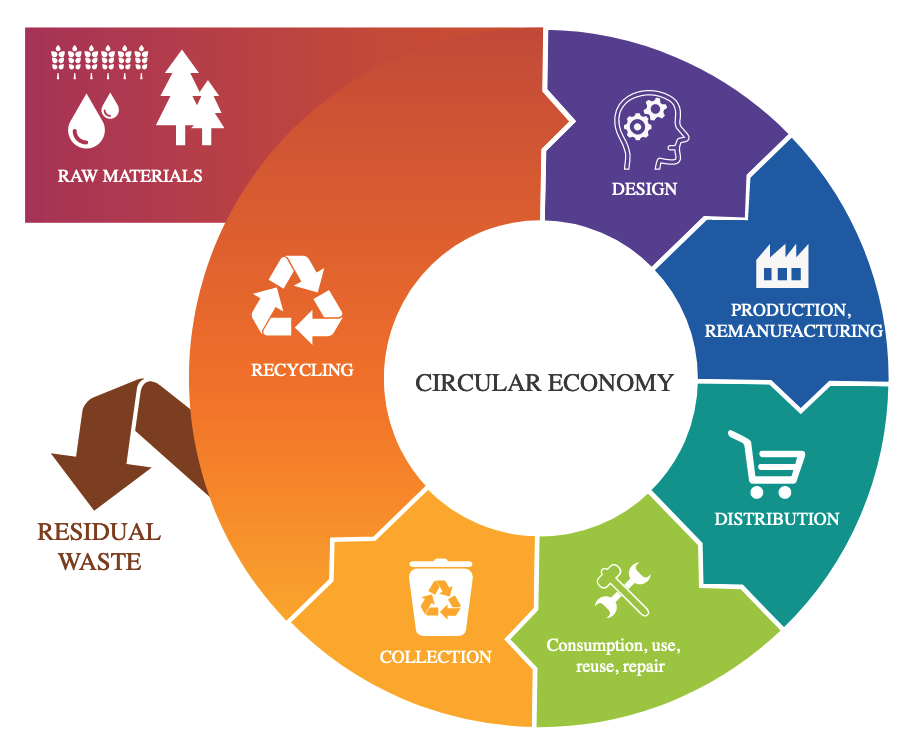
(For a quick 1 minute explanation of the circular economy model, watch this video.)
The Waste Framework Directive, and others before and since, are then codified into law in Portugal and other EU countries. Policies are written. Programs are developed and implemented by Portuguese companies, government agencies and municipalities.
Here’s What’s Really Significant
The Directive also defines a five-step “waste hierarchy” that spells out the order of preference for managing and disposing of waste. The diagram below illustrates the concept.
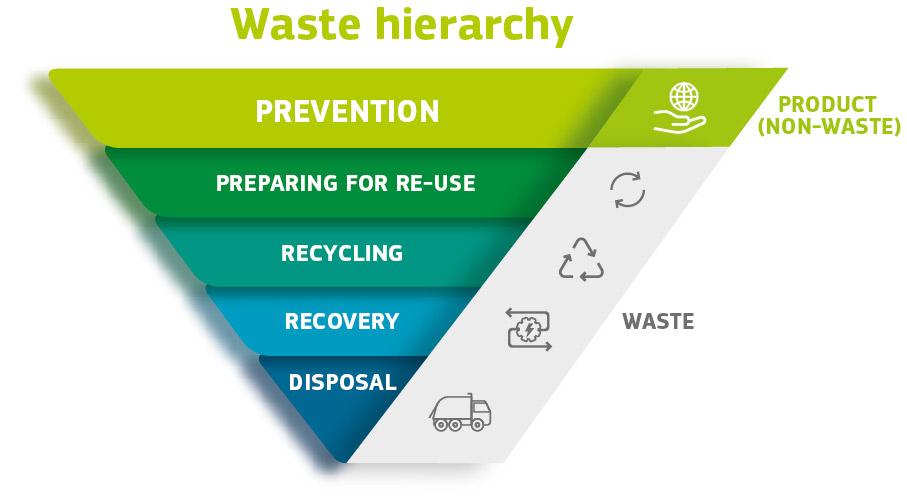
Source: The European Commission
The idea here is that it is better to prevent waste than to dispose of it. The different steps form a funnel that minimize the amount of waste that actually goes to the landfills.
- Prevention: Taking steps to extend the useful life of products, thus preventing them from being discarded. Examples: Designing and manufacturing products to use fewer resources more efficiently and that can be repaired, reused or upgraded, thus extending their lifespan. Encouraging food donation that prioritizes human use over animal feed.
- Preparing for Re-Use: Checking, cleaning or repairing items or their components that have been discarded so they can be reused without further processing. Example: Reconditioning used appliances so they can be resold and reused.
- Recycling: Recovering and reprocessing materials into the same or other types of products. Example: Re-refining used oil, producing paper and cardboard products from discarded materials.
- Recovery: Reclaiming waste materials or components so they can be reused in place of new materials. Examples: Reclaiming land for use in agriculture, using waste material as fuel for generating energy, extracting precious metals from catalytic converters.
- Disposal: The last resort – sending waste to a landfill.
What it means in practical terms
In Porto, and based on what we’ve read, throughout Portugal, there is a consistent approach to implementing the directive.
The most conspicuous aspect – the “tip of the iceberg” – is the presence of the ecopontos on almost every street. You don’t have to go very far to find a place to take your trash and recyclables.
The configurations vary from location to location, but usually include three large bins for recyclable material. These are color coded: Azul (blue) is for paper and cardboard, verde (green) is for glass, and amarelo [sp?] (yellow) is for plastic and metal.
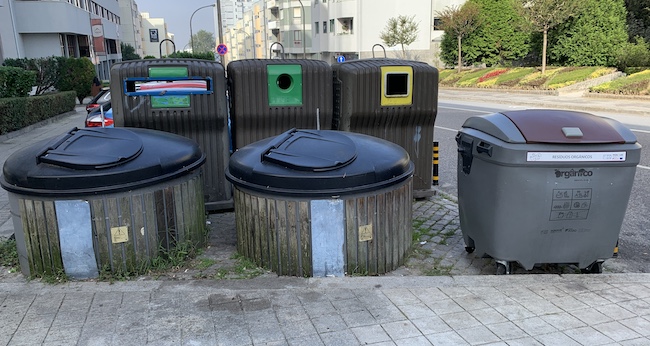
There may also be a bin for resíduos orgânicos – organic waste that can be composted (at right in the photo above). In our neighborhood, these have a locking mechanism to prevent anyone without a special compost box from throwing their trash in with the compostables. You have to apply for access to the composting bin.
Finally, there will be a bin for resíduos indiferenciados – everything that didn’t belong in the other bins. (These are the two round bins above.)
There’s nothing to prevent someone from just tossing everything in the “everything else” bin, and I’m sure that happens. But we always see people doing the sorting and putting things in the proper bins.
We’ve also seen color-coded bags used to collect waste from restaurants and in parks.
They make it easy
Besides having ecopontos on practically every street corner, there are some other aspects of the waste management programs that make it easy for people to do the right thing.
First, practically every type of packaging is recyclable.
Second, by law, most of the packaging has a label that indicates in which bin it should be disposed.
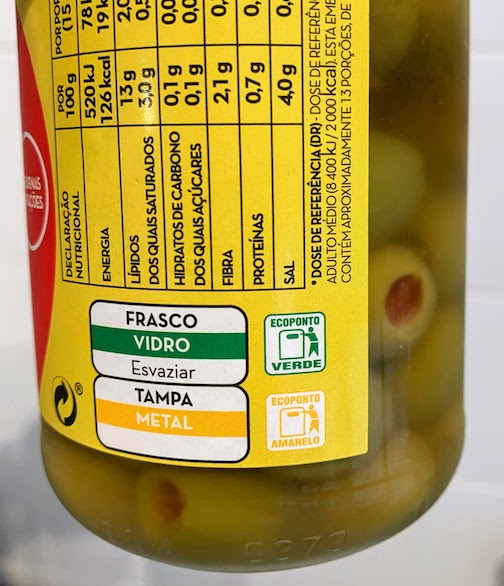
The results are in
Every country in the EU is required to report their progress against the overall waste reduction targets. The published data indicates that Portugal lags behind most other EU countries. A European Environmental Agency report published this year showed that In 2019, Portugal recycled 29% of its municipal waste. This was far short of the 50% target. By contrast, Germany recycled 67%.
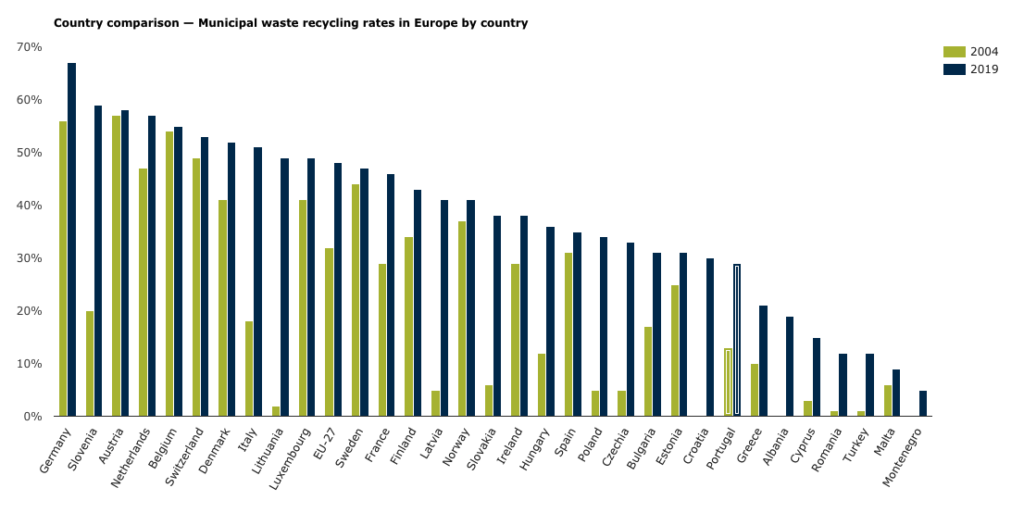
As a result, Portugal was one of several countries that received “early warning reports” from the European Commission that highlighted the risk of missing the target and suggested different steps the country could take to improve.
The Portuguese Environmental Authority reported recently that progress toward the target slowed during 2020 as changes were made in response to the COVID-19 pandemic. Sorting of waste was curtailed in order to protect the workers who did the sorting. This resulted in more waste being sent to landfills.
Reuters reported in 2020 that the pandemic lockdown also increased the use of disposable products, like take out food containers.
Conclusion
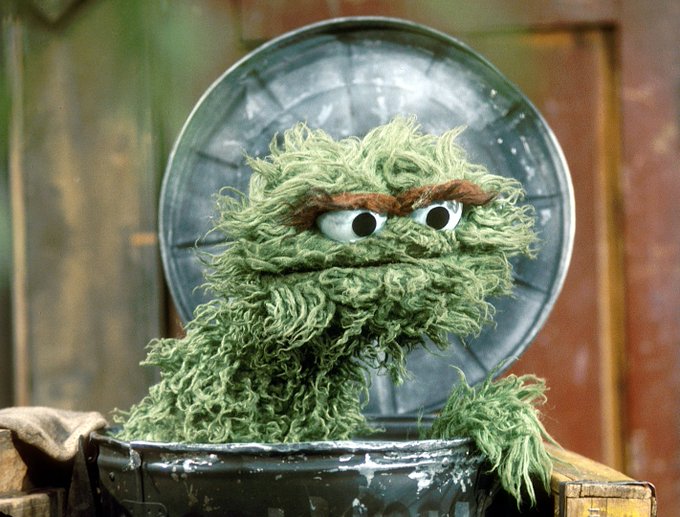
I think I’ve dragged you through the dumpster enough for one day.
There’s a lot more I want to understand about the recycling ecosystem in Europe. And there is a lot more that Portugal, and everyone living here, needs to do to meet the EU targets.
But what’s important is not the number. That’s just a way of keeping score. The important thing is the cumulative impact that a simple act like tossing the empty bottle in the verde bin can have on the environmental health of this country and the entire planet.
How is recycling done where you live? Let’s compare notes. Leave a comment below or send it in via the Contact Form.
Have a great day today! / Tenha um grande dia hoje!
Mike
The Writer
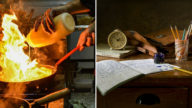
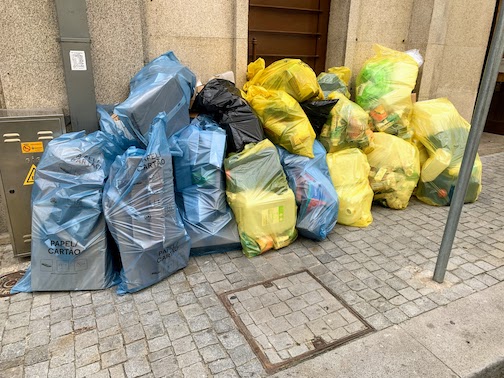
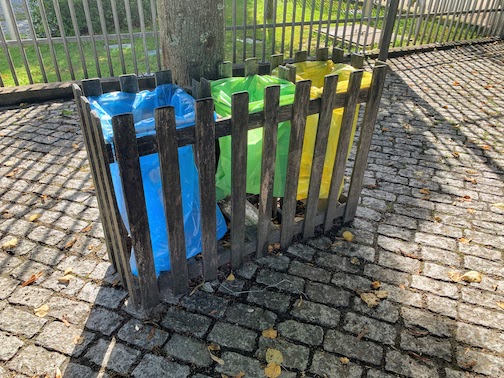

Wow! Thank you for sharing this. So interesting!
Xo,
Nan
Thank you! We are moving to Lisbon in April and have an apartment. I was wondering about how trash is disposed. I like the idea of having to walk somewhere and carry it to a common spot where others can see one’s commitment to recycling. 😊. Great and enlightening article.
Great article! Love to read about the good waste management practices in Portugal and the focus on the circular economy. I wish the US would get on board as well. Interesting to me because of my work in the waste management and sustainability field but important information for everyone to decrease their personal waste.